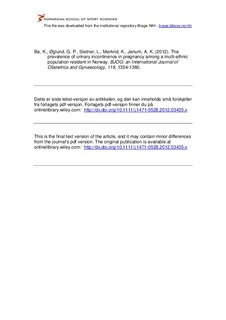| dc.contributor.author | Bø, Kari | |
| dc.contributor.author | Øglund, Guro Pauck | |
| dc.contributor.author | Sletner, Line | |
| dc.contributor.author | Jenum, Anne Karen | |
| dc.date.accessioned | 2013-05-10T07:51:50Z | |
| dc.date.available | 2013-05-10T07:51:50Z | |
| dc.date.issued | 2012-07-25 | |
| dc.identifier | Seksjon for idrettsmedisinske fag / Department of Sports Medicine | |
| dc.identifier.citation | BJOG: an International Journal of Obstetrics and Gynaecology. 2012, 119(11), 1354-1360 | no_NO |
| dc.identifier.issn | 1471-0528 | |
| dc.identifier.uri | http://hdl.handle.net/11250/171146 | |
| dc.description | I Brage finner du siste tekst-versjon av artikkelen, og den kan inneholde ubetydelige forskjeller fra forlagets pdf-versjon. Forlagets pdf-versjon finner du på onlinelibrary.wiley.com: http://dx.doi.org/10.1111/j.1471-0528.2012.03435.x / In Brage you'll find the final text version of the article, and it may contain insignificant differences from the journal's pdf version. The definitive version is available at onlinelibrary.wiley.com: http://dx.doi.org/10.1111/j.1471-0528.2012.03435.x | no_NO |
| dc.description.abstract | OBJECTIVES: To investigate prevalence of urinary incontinence (UI) in a multi-ethnic population of pregnant women, and to analyse for possible associations of the known risk factors for UI in such a population.
DESIGN: Population-based cross-sectional study. SETTING: All pregnant women in three administrative city districts attending the Child Health Clinics.
POPULATION AND SAMPLE: Out of 823 women identified in the [corrected] first trimester, 772 (94%) [corrected] agreed to participate in the study at 28 weeks of gestation. Inclusion criteria were: healthy women at 20 weeks of gestation or less and able to communicate in Norwegian, Arabic, English, Sorani, Somali, Tamil, Turkish, Urdu or Vietnamese.
METHODS: Differences between ethnic groups were tested by simple descriptive statistics. Associations were estimated by logistic regression analysis and presented as crude (cOR) and adjusted (aOR) odds ratios.
MAIN OUTCOME MEASURES: Prevalence of UI as ascertained using the International Consultation on Incontinence Questionnaire-urinary incontinence-short form.
RESULTS: Prevalence rates of UI at 28 weeks of gestation were 26% for women of African origin, 36% for women of Middle Eastern origin, 40% for women of East Asian origin, 43% for women of South Asian origin and 45% for women of European/North American origin. The difference was significant between women of African and European/North American origins (P = 0.011) and between women of African and South Asian origins (P = 0.035). Age (aOR 1.05; 95% CI 1.01-1.09) and parity (aOR 2.34; 95% CI 1.66-3.28) were positively associated with the prevalence of UI in pregnancy. Women of African origin had significantly reduced odds for UI (aOR 0.42; 95% CI 0.20-0.87). East Asian and African women reported the highest perceived impact of UI in pregnancy.
CONCLUSIONS: A high prevalence of UI was found in a multi-ethnic pregnant population. | no_NO |
| dc.language.iso | eng | no_NO |
| dc.publisher | John Wiley & Sons | no_NO |
| dc.subject | cross-sectional studies | no_NO |
| dc.subject | ethnic groups | no_NO |
| dc.subject | Norway | no_NO |
| dc.subject | epidemiology | no_NO |
| dc.subject | pregnancy | no_NO |
| dc.subject | pregnancy complications | no_NO |
| dc.subject | prevalence | no_NO |
| dc.subject | questionnaires | no_NO |
| dc.subject | risk factors | no_NO |
| dc.subject | urinary incontinence | no_NO |
| dc.title | The prevalence of urinary incontinence in pregnancy among a multi-ethnic population resident in Norway | no_NO |
| dc.type | Journal article | no_NO |
| dc.type | Peer reviewed | no_NO |
| dc.subject.nsi | VDP::Medical disciplines: 700::Clinical medical disciplines: 750::Gynecology and obstetrics: 756 | no_NO |
| dc.source.journal | BJOG: An International Journal of Obstetrics and Gynaecology | |
| dc.identifier.doi | 10.1111/j.1471-0528.2012.03435.x | |
